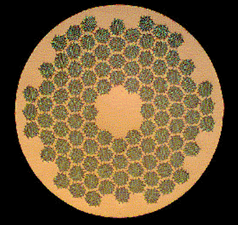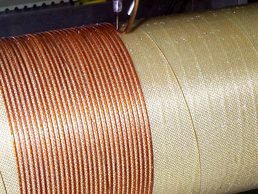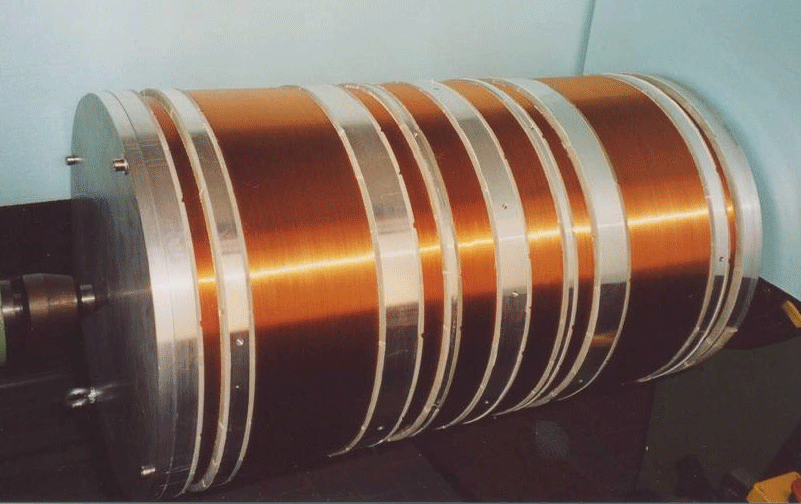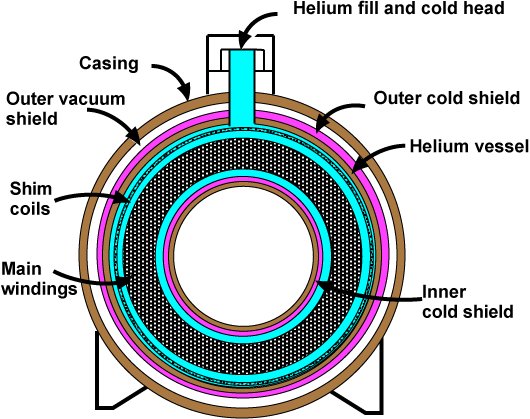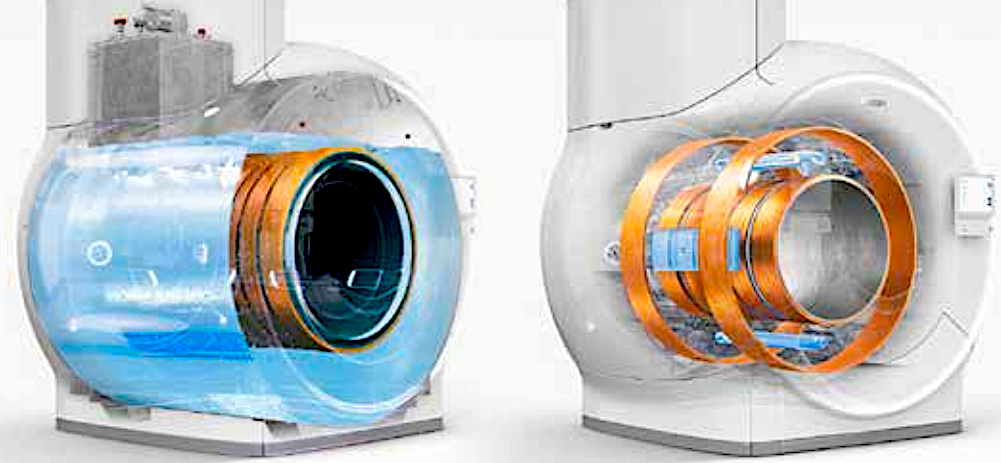|
The conductor used in nearly all modern superconducting MR scanners is niobium-titanium (NbTi) that becomes superconductive below 9.4°K. Each wire is composed of multiple NbTi microfilaments embedded in a copper core. The copper core has two functions: 1) to support and protect the delicate microfilaments; and 2) to serve as a low resistance path for large currents in the event superconductivity is lost. Scanners and spectrometers with field strengths greater than 10T frequently use a niobium-tin (Nb3Sn) alloy. Magnesium diboride (MgB2) is also emerging as a new superconducting material for scanners and other magnetic instruments because of its much higher transition temperature (39°K).
|
|
The wires are wound onto either a glass-reinforced polymer or aluminum former (cylinder) in layers separated by epoxy and dividers. Rather than using a single continuous main field winding, homogeneity is improved by breaking up the main coil into 6-10 separate windings with gaps.
|
The main magnet windings are bathed in liquid helium (4°K) in a structure called a cryostat. The cryostat is a multi-compartmental structure that functions like a Thermos bottle. It contains not only the main magnet windings and channels for liquid helium, but also various insulating and vacuum layers to thermally shield the coils from the warm external environment. The cryostat also typically contains superconducting shim coils (to improve homogeneity) and active shielding coils (to minimize stray/fringe fields).
The external casing of the cryostat as well as the helium vessel inner and outer shells are typically made of non-magnetic stainless steel. The walls of the vacuum chambers are constructed of either nonmagnetic stainless steel or glass-reinforced polymer. The cold shields are typically 3-10 mm thick and made from a low emissivity/high thermal conductivity material such as aluminum.
The external casing of the cryostat as well as the helium vessel inner and outer shells are typically made of non-magnetic stainless steel. The walls of the vacuum chambers are constructed of either nonmagnetic stainless steel or glass-reinforced polymer. The cold shields are typically 3-10 mm thick and made from a low emissivity/high thermal conductivity material such as aluminum.
Because of global helium shortages and increased expense, vendors have developed new scanner designs that use only a small amount (~ 10 L) of liquid helium that is sealed into the scanner during manufacturing and never needs to be refilled. The magnet coils sit in a vacuum rather than within a liquid helium bath. They are in contact with cooling tubes that circulate liquid helium from their small storage compartments. During unexpected loss of superconductivity, no gaseous helium can escape. Thus these systems do not require a quench tube making them easier to site. Examples include GE's Freelium, Siemens DryCool, and Philips' BlueSeal magnets.
Advanced Discussion (show/hide)»
No supplementary material yet. Check back soon.
References
BlueShield Magnet. Koninklijke Philips N.V, 2018. (sales brochure)
Superconduction.org website. (Good explanations of superconductivity and the latest news about room temperature superconductors and other advances in the field).
Superconducting Magnets. Wikipedia, The Free Encyclopedia.
BlueShield Magnet. Koninklijke Philips N.V, 2018. (sales brochure)
Superconduction.org website. (Good explanations of superconductivity and the latest news about room temperature superconductors and other advances in the field).
Superconducting Magnets. Wikipedia, The Free Encyclopedia.
Related Questions
Isn't superconduction like perpetual motion? Doesn't the current in the superconducting coils ever slow down?
Don't superconducting scanners consume liquid helium? How often does it need to be replenished?
Isn't superconduction like perpetual motion? Doesn't the current in the superconducting coils ever slow down?
Don't superconducting scanners consume liquid helium? How often does it need to be replenished?

